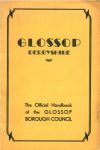 The Official Handbook of the Glossop Borough Council, circa 1933/34
HISTORICAL
The Official Handbook of the Glossop Borough Council, circa 1933/34
HISTORICAL
It would be impossible to find a place in England that could not say that its roots were deep down in history, and tell of things that happened in the mists of bygone days, and Glossop like those places, has its history. It could hardly be otherwise in a place that was part of the domain of the great William Peveril ; paid tribute to the powerful Prior of Lenton ; was ruled by the kingly John Talbot, Earl of Shrewsbury of whom, when he was made Governor of Ireland in 1466 it was said “ There came not from the time of Herod one so wicked in evil ways ” ; that acknowledged as Lords of the
Manor, the gaoler of Mary Queen of Scots, and the famous Courtier Thomas Howard, Earl of Arundel, eldest son of the equally famous Philip Howard who died in the Tower.
Yet, through the centuries Glossop pursued the “ even tenour of its way ” and apart from a well-authenticated protest to the Privy Council by the Tenant farmers against the iniquities of an Earl of Arundel, whose case at Court was defended by the husband of Dorothy Vernon—Lord John Manners—there were no great disturbances. Glossop was peacefully rural, out of the track of national uprisings. Philipp Kynder in his quaint MS., “ Historie of Darbyshire,” surveys from the Peak mountains the “ bordering counties . . . weltering in gore and blood ” during the Civil Wars and speaks of his County as “ calme in the midst of boisterous waters.”
With the coming of the Industrial Revolution, Glossop became vibrant with life. In 1775 the only mill in the parish was the Manorial Com Mill and the population, estimated at 5,000 souls, obtained their livelihood at one of the cottage industries, or on the land, or by a combination of the two.
The whole face of industry was revolutionised by the application of steam power to machinery by Watt, and enterprising manufacturers on the look out for sites with adequate water supplies discovered this rural area with its abounding streams. Mills began to rise, people flocked from other counties and countries to the new factories, and by 1829 the number of mills was fifty-six and they were manufacturing cotton, flax, wool, silk, cambric, muslin, paper, etc.
During this great uprising of trade activity, some of the best-known manufacturing concerns of Glossop were born. Mr. John Wood, assisted by his three sons, John Hill, Daniel, and Samuel, commenced at the Old Water Mill in Old Glossop in 1815 ; Edmund Potter at the Print Works (now the C.P.A.) in 1825 ; Francis Sumner in 1827 ; and Samuel Oliver at the Logwood Mill in 1833.
The cottage industry had served its day well, but it had been superseded by the age of the power machine, and the history of Glossop in the later years centred around the doings of the men who conducted its industry and those who gave spiritual ministration to its souls.
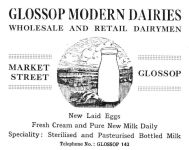

LOCAL GOVERNMENT
Glossop is a non-county borough and is governed by a town council consisting of the Mayor, six aldermen and eighteen councillors. The Charter of Incorporation was obtained in 1866, the agitation for which being started by the necessity for some statutory body to administer the Swineshaw Waterworks, the purchase of which from Lord Edward Howard for the use of the town was in contemplation.
During the last decade the water system has been thoroughly overhauled, new mains laid over the greater part of the two wards supplied from this source, and a boosting plant of the very latest principle installed in 1932 ensures a pure supply at good pressure in the Whitfield area, the highest part of the borough.
The Hadfield water system was purchased at the break up of the Howard Estate in 1927. There is here a very good and sufficient supply at a higher pressure than water from the Swineshaw, and as a result of the installation of a mechanical filtration plant in 1932 the water is delivered to the dwellings clear, bacteriologically pure, and of the required hardness.
The sanitation of the whole town is by water-carriage. All are under the control of the Borough Engineer, Mr. G. Faulds, M.Inst. M. and C.E.
The borough is part of the High Peak Division of Derbyshire, the Member for the Division being Sir Alfred Law, M.P.
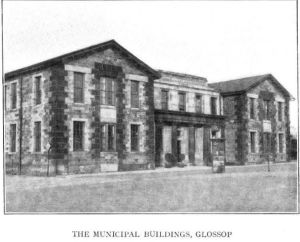
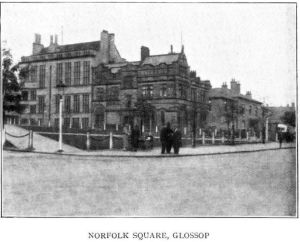
The Municipal Offices are a magnificent pile in the centre of the town, fronting a splendid covered market. Immediately opposite the Town Hall (where the Police Courts are held), is a beautiful open space, known as Norfolk Square, which has recently been laid with turf, and enclosed with massive chain and posts, by and through the generosity of the Hon. Mrs. Bennett-Sidebottom, the eldest daughter of the late Lord Doverdale (formerly Captain Partington), the founder of the famous paper-making firm of Olive and Partington Ltd., whose fine mills now form part of the Inveresk group.
The Municipal Buildings, the Town Hall and Market, are gifts of the late Isaac Jackson, founder of the world-famed belt-fastener firm, whose works occupy an extensive site known as Hawkshead, at Old Glossop.
EDUCATION
Glossop has an excellent system of education. In addition to nursery, infant and junior schools, there are two co-educational, non-selective central schools dealing with elementary education. The central schools are Provided Schools, and there are in addition Anglican and Methodist junior schools and Roman Catholic schools in which juniors and seniors are as yet intermingled.
Higher educational facilities are provided by the Grammar School, the building of which was presented to the town by the late Lord Howard ; the school has a high reputation for scholarship, and a remarkable record of successes in both the academic and professional spheres. Free places in the school are presented by the County Council and the Joseph Hague Educational Endowment upon the results of the Minor Scholarships Examination. The Harriet and Isaac Jackson Trust also sponsor pupils at their discretion. The school has won a relatively large number of major and state (University) scholarships. Mr. C. H. Chambers, B.Sc., B.Eng., is the headmaster, and the Education Secretary is Mr. Roger Rose, the Town Clerk.
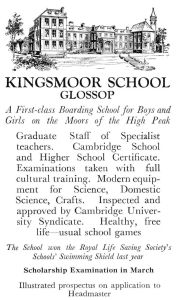
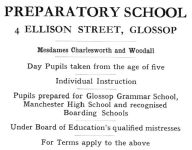
There has also been established a large residential school —Kingsmoor—the building of which was the residence of the late Lord Howard, which is putting into operation an educational scheme on new outlook lines, individual training being largely used, arts and crafts, music, dancing, and the drama forming a special feature of the school life. Headmaster : Captain G. R. Swaine, A.C.P. (Hons.), F.R.Met.Soc.
There are in addition two preparatory schools—Mesdames Woodall and Charlesworth at Glossop, and Mrs. Vernon Thomas, B.A. at Hadfield.
ELECTRICITY
The Urban Electric Supply Co. are the undertakers and by dint of a forward policy are increasing the consumption of current both for illumination, domestic and power uses at a steady rate.
GAS
This is as yet, the principle source of radiant and illuminating power in Glossop for household purposes and this is due in no small measure to the fact that the management is very wide awake and gives rapid and satisfactory service to customers. The streets are lighted by both electricity and gas.
PARKS AND RECREATION GROUNDS
There are few places in the country so well placed for parks and recreation grounds as Glossop.
With the break-up of the Glossop-Dale Estate, the Corporation purchased Glossop Hall and Grounds. The Hall was let as a school—Kingsmoor School referred to previously—and the sixty acres of garden, lakes, streams, and fields, converted into a wonderful public park. It was very suitably named Manor Park. Here are magnificent walks, a children’s playground, the best of hard tennis courts, and the most picturesque scenery to be found throughout the County of Derbyshire.

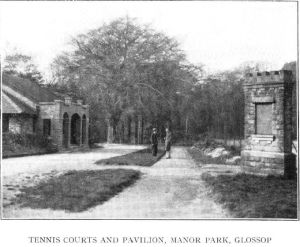
A paddling pool and model yacht pond have been constructed, and bowling greens and putting greens are in continuous demand through the summer months. The Town Council has erected a substantial pavilion with dressing-rooms and cafe which add greatly to the amenities of the park. Rustic bridges span a stream which winds its way through artistically laid grounds, and through patches of woodland beauty, with majestic elms, oaks and beeches, providing a spectacle of great beauty.
Here also in Manor Park is to be seen an unusual War Memorial. With the consent of the Town Council, the local branch of the British Legion constructed a Garden of Remembrance. Several thousand rose trees, all blooming red, are massed in beds traversed by paths. At the entrance is a memorial stone, and the whole is surrounded by funereal yews. Every July, when the garden is red with roses and the air heavy with their perfume, the Legion hold a Service of Remembrance which is attended by a vast concourse of people.
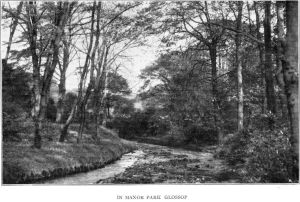
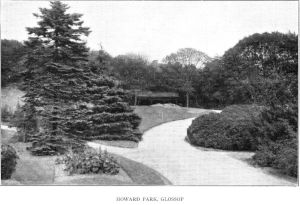
Not far distant is Howard Park—a Jubilee gift of the late Lord Howard—with its formal flower beds, lawns, and ornamental lake, where folk find quiet and seclusion amidst its beautiful shrubberies.
In the Hadfield portion of the town, Bankswood Park, a long stretch of grassland, woodland, and hill is a place of great resort. Here, too, are to be found excellent tennis courts. There are five recreation grounds in the borough, one of which the Pyegrove is very extensive.
PUBLIC BATHS
The Public Baths are situated in Howard Park. They have a swimming pool second to none in the country, a system of continuous water filtration and aeration making every day fresh-water-day.
There is also a Bath House at Hadfield, where slipper baths are in use all the year round.
HOSPITALS
Glossop is amazingly well equipped with Hospitals. The Council own the Isolation Hospital, where are treated all infectious diseases. Wood’s Hospital, the gift of the late Daniel Wood has recently been reorganised and completely modernised by the erection of a first-rate operating theatre, this being the gift of the Ogden Trust.
The hospital is now always full, persons requiring serious major operations being dealt with here instead of having to suffer a dreary wait for a bed in one of the Manchester hospitals. All accident cases are now rushed to Wood’s Hospital, many of them being motor accident cases which have occurred on the roads leading through Glossop to the Peak. The chief surgeons are Dr. Mamourian for men ; Dr. Hunter for women.
The late Lord Doverdale presented to the town a Convalescent Home, but because the need was greater and in keeping with the modern demand for the reduction of infantile mortality, the Convalescent Home was transformed into an up-to-date Maternity Home, possessing every modern scientific device for childbirth. The fees are very reasonable, and poor cases are admitted free at the discretion of the appropriate Corporation Committee. Here also are quartered the Queen’s nurses, who do a vast amount of good work in the town.
Co-existent with the established hospitals are the clinics of the Corporation, which are operated jointly by the Education and Maternity and Child Welfare Committees. There are ante-natal, dental, optical, sun-ray, orthopaedic and minor ailments clinics, and a weekly clinic at Glossop and Hadfield for infants. All are under the supervision of the Medical Officer of Health, Dr. E. H. M. Milligan, who is also the Medical Officer in charge of the Hospitals, School Medical Officer and Police Surgeon.
The Town Council possess three ambulances, one of which was presented by the Isaac and Harriet Jackson Trust, and serves all adjacent districts.
FIRE BRIGADE
The town is equipped with an efficient Fire Brigade, possessing two modern motor fire engines and appliances. The Brigade is manned by police, covers all adjoining districts, and is commanded by Mr. R. C. Greensmith, who is also Chief Constable.
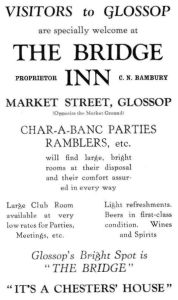
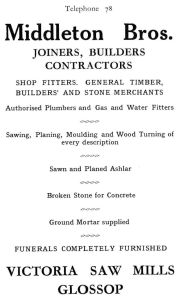
PLACES OF WORSHIP
The ancient ecclesiastical parish of Glossop was almost as extensive as a diocese, the Parish Church, a very ancient house of prayer, being situated at the extreme northeasterly end of the parish at the foot of the Pennine Hills that bar the way to Sheffield.
As manufactories were established during the Industrial Revolution, development tended to be not round the mother church but away from it, and, owing to the influx of people who obtained employment in the then newly developing cotton industry, colonies were established at such a distance from
the Parish Church as to render spiritual service well-nigh impracticable. Hence, the Vicar, the Rev. Christopher Howe, took the courageous step of assisting in the break-up of his parish into a number of ecclesiastical parishes, and with the consecration of the Church of St. Andrew at Hadfield in 1874, the culmination point was reached ; the ancient ecclesiastical Parish of Glossop had been broken up into six different parishes, four of which lie within the administrative Borough of Glossop.
Although the seat of an ancient parish, the church at Old Glossop is not ancient. The body of the church was rebuilt in 1831, the cost being borne by the parishioners. A few years later the chancel and, in 1853, the spire were rebuilt, both at the expense of the lay rector, the Duke of Norfolk.
According to an account contemporary with the rebuilding of the spire, the old church was an interesting example of Early English architecture, the leading characteristics of which were reproduced in the Roman Catholic Church at New Mills, which was built in 1845. Anterior to rebuilding, the chancel was entered on the south side by a Norman doorway, with toothed ornamentation, Early English double lancets lighted the north and south sides of the chancel, whilst the west was pierced with a triple window.
Glossop Church was not one of those whose architectural features were wantonly destroyed during the wave of church rebuilding in the early thirties of the last century. The accounts of the churchwardens for over a hundred years prior to the rebuilding make it abundantly clear that it was in a tumbledown condition. The earliest reference to the church is in the Easter book for the Parish of Glossop for the year 1433. The chancel was rebuilt in 1923, at the cost of Mrs. Harriet Jackson of Hawkshead, Glossop. The present Vicar is the Rev. F. J. Edmond, M.A., F.R.G.S.
ST. JAMES’ CHURCH, WHITFIELD
This was the first parish to be constructed out of the ancient parish. The church was built in 1846. The Vicar and Rural Dean is the Rev. H. V. Nicoll-Griffith, M.A.
ST. ANDREWS’ CHURCH, HADFIELD
This, with its Mission Room at Woolley Bridge serves the Hadfield Ward of the Borough. It was built in 1874. The Vicar is the Rev. A. C. M. White, L.Th.
HOLY TRINITY CHURCH
Situate in Dinting Vale and serving the Anglicans of Dinting and Gamesley. The church was built in 1875, an extension being made in 1931. The Vicar is the Rev. L. Foster, L.Th.
NONCONFORMIST CHURCHES: INDEPENDENTS
From the earliest days Nonconformity found fertile soil in Glossop. The Rev. William Bagshaw became Vicar of Glossop in 1651. From what happened later it is clear that in the Parish of Glossop there was a distinct body of Dissenters. In 1662, on the passing of the Act of Uniformity after the Restoration, 2,000 ministers were ejected from their benefices, and amongst these was the Vicar of Glossop, who, refusing to be silenced, rode over the hills preaching, and became known as the “ Apostle of the Peak.” A return to Quarter Sessions in 1677 showed that there were fifty-two Nonconformists in
Glossop. There is consequently a strong community of Independents in and about Glossop.
The Chapel at Littlemoor was built in 1811 and there are also chapels at Mount Pleasant, Brookfield, and Padfield. The ministers are the Revs. A. W. Bairstow, A. W. Goodwin and J. H. Robinson.
METHODISTS
There is no evidence that John Wesley preached in any Glossop chapel, but according to his Diary, he preached “ in the midst of the Derbyshire Mountains,” at Bridgefield, on March 27th, 1761.
The Wesleyans were prior to the Act of Union a strong body in Glossop. Their earliest chapels were built at Whitfield and Old Glossop in 1813. These chapels, still strong communities, were later reinforced by the chapels at Glossop, Hadfield, and Padfield.
The Primitive Methodists also established themselves in Glossop well over a century ago, and strong communities worship at the Shrewsbury Street, Princess Street, and Hadfield Chapels. The United Methodists have chapels at Ebenezer Street, Simmondley Lane, Manor Park Road, and Station Road, Hadfield, whilst the Wesleyan Reformers have a chapel at Howard Street.
The Unitarians, notable for their educational work in Glossop over a century ago, have a chapel in Fitzalan Street.
ROMAN CATHOLICS
The Lords of the Manor of Glossop, with the notable exception of those Dukes of Norfolk who became Protestant, have been Catholics. It is singular therefore that until the last century there did not exist a considerable body of Catholics in Glossop. In the Quarter Sessions return mentioned above, we learn that there were “ four papists ” in Glossop. Rather less than a hundred years earlier, Nicholas Garlick of Glossop, ordained priest at Rheims, had been captured at the seat of the Fitzherberts, and was hung, drawn, and quartered.
Now, following an influx of labour to the cotton mills during the early years of the last century, there are three strong communities of Catholics in Glossop.
All Saints, built in 1836 by the Duke of Norfolk, is in Old Glossop. The Rev. Father Ketels is the Priest.
St. Mary’s, built in 1887 from a bequest by the late Francis J. Sumner, one of the pioneers of the cotton industry in Glossop. The Priest and Rural Dean is the Very Rev. Canon Winder.
St. Charles, in Hadfield, built by the late Lady Howard of Glossop. The Priest is the Rev. Father Ellis.


PLACES OF INTEREST WITHIN A SHORT DISTANCE OF GLOSSOP
OVER THE SNAKE PASS
Scenery very reminiscent of the Langdale Pikes in the Lake District is to be found on the route well known as the Snake Pass. Take the bus to the Snake from Glossop, thence over the well-defined track across the moors to Kinder, and return by bus from Hayfield.
CHATSWORTH, HADDON HALL, BAKEWELL, DARLEY DALE AND MATLOCK
A trip that appeals with great force to most people is that to Matlock and neighbourhood. There can hardly be a doubt that the route, passing as it does through the wild moorland scenery of the Snake Pass, through woodland and meadow, by the stately pile of Chatsworth and the romantic home of one of the world’s greatest love stories, Haddon Hall, and the towering crags of Matlock, is probably unparalleled in the British Isles for its wealth and diversity of beautiful scenery. Matlock has many attractions peculiarly its own—caverns, tors, its glorious Masson Hill, and a delightful boating river.
Quite close at hand are other sights well worth visiting, and which Glossop folk appear to think out of range. Darley Dale, through which the bus passes some two miles before reaching Matlock, possesses an interesting church with stone coffins and sculptured lids, and many monuments in effigy going back to the fourteenth century. There is also evidence of the existence of a “ leper’s squint,” a narrow slit in the masonry of the chancel commanding a view of the altar, through which in the days when leprosy was a very common disease in England, those affected were permitted to observe, and
were considered to have participated in, the celebrations at the altar. It has here been walled up, but the evidence appears fairly clear.
There is at Eyam Church a “ leper’s squint ” in its original state.
In addition, there is a magnificent yew tree, which, 4 ft. from the ground, measures 33 ft. round the trunk. It is considered by many authorities to be the finest yew tree in the British Isles, and Dr. Cox, the famous Derbyshire antiquary, estimated its age to be nothing less than 2,000 years. In distinct comparison with some of the famous oaks, such as the Major Oak and Robin Hood’s Larder in Sherwood Forest, the Darley Dale yew is firm and solid, and is likely to last a good many more years.
Wirksworth, some two miles out of Matlock, has also a magnificent church, which has been described in competition with Tideswell, the “ Cathedral of the Peak.” It has many ancient monuments, tablets, and brasses to the aristocratic families of long standing of the neighbourhood. The name of the Gells is perpetuated here, and it is held locally that one of the family, Sir John Gell, who was on the side of Parliament during the Civil War, marched his retainers to Wingfield Manor as a relief force down the road that is well known as Via Gellia.
Wirksworth has been for centuries the seat of the Derbyshire lead-mining industry, and a quaint curio to be seen in a rather ugly building known as the “ moot hall ” is an ancient miner’s dish. This is a heavy copper vessel, chained to the wall, on which is an inscription to the effect that it was made in the “ iiij yere of the reign of Kyng Henry VIII before George, Earle of Shrewsbury,” and “ this dishe to remayne in the Moot Hall at Wyrkysworth, hangyng by a cheyne so as the merchauntes or mynours may have resorte to the same at all tymes to make the true mesure after the same.” The dish held fourteen pints of lead.
Another excellent little jaunt, if time permitted, would be to visit the famous ruins of Wingfield Manor. This is described by Firth in “ Highways and By-ways of Derbyshire ” thus: “ One of the most fascinating of English ruins ; has charm of situation, charm of grace in the ruins themselves, and, above all, charm of association.” This is not an exaggerated description. It is a magnificent pile, in such a state of preservation that two of the towers can be ascended. In the height of its glory it was owned by the nobleman who was also the owner of the manor and rectory of Glossop—George Earl of
Shrewsbury.
It was in this Manor House that the Earl of Shrewsbury was the gaoler of Mary, Queen of Scots, and I believe it was from here that the Queen was moved to Fotheringay Castle to be executed.
Crich Stand was a tower on the top of a hill in the neighbouring village of Crich. It was built in 1788, but I do not think it has many historical associations. Since the war, however, a new tower has been erected near the site of the old one, and this, for Glossop people as well as others, has great sentimental interest, for it is now the memorial to the soldiers of the Sherwood Foresters who gave their lives during the late war.
A few miles from here, nearer Matlock, is “ Lea Hurst,” the home of the lady who was the mother of our nursing services, Florence Nightingale, “ the Lady of the Lamp.” The return trip may be made by way of Buxton.
Now as to the question of getting there, if you do not possess a car, the local bus service has its convenient “ anywhere ” ticket, but those intending to go into this part of Derbyshire might also consider the advisability of combining bus and train via Chinley. That is, of course, if cheap tickets are available from that place. The L.M.S. Railway now issues a weekly ticket for anywhere in Derbyshire for 10s. To the places I have mentioned, and also to such extremely interesting places as Winster, with its quaint market hall ; Youlgreave, with its ancient church, containing in its register the famous entry about the Great Snow in the seventeenth century, and its close proximity to the beautiful Lathkill and Bradford Dales; Bonsall, with its splendidly preserved Butter Cross, with which we have no space to deal ; to all these places buses regularly leave Crown Square and Station Yard at Matlock.
J.D.D.
THE NORFOLK HOTEL
One minute from the station and right in the centre of the town is the only haven of rest which Glossop offers to its visitors. Have no fear, however, for this hotel is fully aware of its importance and deserves to be recommended in every way.
No more comfortable and convenient spot could be found from which to tour the beauties of the Peak District.
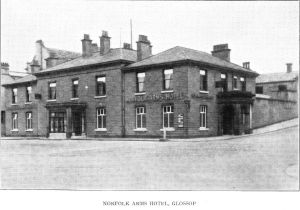
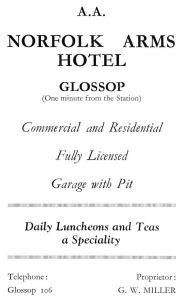
Much of the history of the hotel seems to have been buried with the past, but one can easily imagine the festive events with which it has been associated when it is mentioned that the Local Cricket Club has just celebrated its Centenary. The hotel has been, from the commencement, the Club’s headquarters.
Recently modernised and the premises extended, the old-world atmosphere is now combined with modern comfort. There are eleven bedrooms. Lounge fitted with latest type of basket furniture. Buffet-Bar and combined Social and Billiard Room.
Another useful innovation is a garage, provided with a pit, for use of all visitors.
Return to GJH.me Home Page, Return to Glossop Area Local Histories index.
Last updated: 31 January 2021
 The Official Handbook of the Glossop Borough Council, circa 1933/34
The Official Handbook of the Glossop Borough Council, circa 1933/34 The Official Handbook of the Glossop Borough Council, circa 1933/34
The Official Handbook of the Glossop Borough Council, circa 1933/34














